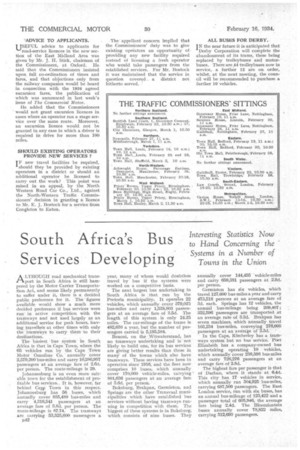South Africa's Bus Services Developing
Page 52

If you've noticed an error in this article please click here to report it so we can fix it.
Interesting Statistics Now to Hand Concerning the Systems in a Number of Towns in the Union ALTHOUGH road mechanical transport in South Africa is still hampered by the Motor Carrier Transportation Act, and seems likely permanently to suffer under it, there is a decided public preference for it. The figures available would show a much more decided preference if bus services were run in active competition with the tratros ays and not used largely as an additional service for peak hours, leaving travellers at other times with only the tramways to carry them to their destinations.
The busiest bus system in South Africa is that in Cape Town, where the 65 vehicles run by the Cape Town Motor Omnibus Co. annually cover 2,579,200 bus-miles and carry 10,286,957 passengers at an average fare of 2.6d. per person. The route-mileage is 29.
Johannesburg is an even more suitable town for the establishment of profitable bus services. It is, however, far behind Case Town in this respect. Johannesburg has 56 buses, which annually cover 935,480 bus-miles and carry 4,316,511 passengers at an average fare of 3.8d. per person. The route-mileage is 87.74. The tramways are carrying 53,525,600 passengers a B42 year, many of whom would doubtless travel by bus if the systems were worked on a competitive basis.
The next largest bus undertaking in. South Africa is that run by the Pretoria municipality. It operaies 22 vehicles, which annually cover 379,025 bus-miles and carry 1,538,803 passengers at an average fare of 3.5d. The length of this system is only 24.25 miles. The car-mileage of the trams is 482,670 a year, but the number of passengers carried is 5,195,584.
Benoni, on the Witwatersrand, has no tramways undertaking and is not likely to build one, for its bus services are giving better results than those in many of the towns which also have tramways. These services have been in operation since 1916, and the fleet now comprises 10 buses, which annually cover 170,660 vehicle-miles, carrying ' 801,636 passengers at an average fare of 3.6d. per person.
Boksburg, Brakpan, Germiston, and Springs are the other Transvaal municipalities which have established bus services without having tramways running in competition with them. The biggest of these systems is in Boksburg, which consists of nine buses. They annually cover 144,455 vehicle-miles and carry 659,381 passengers at 2.9d. per person.
Germiston has six vehicles, which travel 127,600 bus-miles a year and carry 473,518 persons at an average fare of 3d. each. Springs has 12 vehicles, the annual bus-mileage being 209,407; 352,596 passengers are transported at an average rate of 3.3d. Brakpan has seven machines, which annually travel 103,234 bus-miles, conveying 276,000 passengers at an average of 3.3d. '
In the Cape, Kimberley has a tramways system but no bus service. Port. Elizabeth has a company-owned bus undertaking operating 10 vehicles, which annually cover 238,598 bus-miles and carry 726,276 passengers at an average fare of 2.8d.
The highest fare per passenger is that of Durban, where it stands at 6.4d. This city has 17 vehicles in service, which annually run 301,925 bus-miles, carrying 687,509 passengers. The East London service, run with six buses, has an annual bus-mileage of 123,422 and a passenger total of 605,946, the average fare being 2.4d. The Bloemfontein buses annually cover 78,822 miles, carrying 312,690 passengers.




















































































